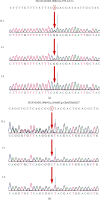A Novel Spontaneous Mutation of the SOX10 Gene Associated with Waardenburg Syndrome Type II
- PMID: 32908492
- PMCID: PMC7474791
- DOI: 10.1155/2020/9260807
A Novel Spontaneous Mutation of the SOX10 Gene Associated with Waardenburg Syndrome Type II
Abstract
Waardenburg syndrome (WS), also known as auditory-pigmentary syndrome, is the most common cause of syndromic hearing loss. It is responsible for 2-5% of congenital deafness. WS is classified into four types depending on the clinical phenotypes. Currently, pathogenic mutation of PAX3, MITF, EDNRB, EDN3, SNAI2, or SOX10 can cause corresponding types of WS. Among them, SOX10 mutation is responsible for approximately 15% of type II WS or 50% of type IV WS. We report the case of a proband in a Chinese family who was diagnosed with WS type II. Whole exome sequencing (WES) of the proband detected a novel heterozygous spontaneous mutation: SOX10 c.246delC. According to analysis based on nucleic acid and amino acid sequences, this mutation may produce a truncated protein, with loss of the HMG structure domain. Therefore, this truncated protein may fail to activate the expression of the MITF gene, which regulates melanocytic development and plays a key role in WS. Our finding expands the database of SOX10 mutations associated with WS and provides more information regarding the molecular mechanism of WS.
Copyright © 2020 Sen Chen et al.
Conflict of interest statement
The authors declare that they have no competing interests.
Figures




Similar articles
-
The clinical and genetic research of Waardenburg syndrome type I and II in Chinese families.Int J Pediatr Otorhinolaryngol. 2020 Mar;130:109806. doi: 10.1016/j.ijporl.2019.109806. Epub 2019 Nov 29. Int J Pediatr Otorhinolaryngol. 2020. PMID: 31812001
-
Two novel mutations of PAX3 and SOX10 were characterized as genetic causes of Waardenburg Syndrome.Mol Genet Genomic Med. 2020 May;8(5):e1217. doi: 10.1002/mgg3.1217. Epub 2020 Mar 13. Mol Genet Genomic Med. 2020. PMID: 32168437 Free PMC article.
-
Novel mutations of PAX3, MITF, and SOX10 genes in Chinese patients with type I or type II Waardenburg syndrome.Biochem Biophys Res Commun. 2010 Jun 18;397(1):70-4. doi: 10.1016/j.bbrc.2010.05.066. Epub 2010 May 15. Biochem Biophys Res Commun. 2010. PMID: 20478267
-
Genetic insights, disease mechanisms, and biological therapeutics for Waardenburg syndrome.Gene Ther. 2022 Sep;29(9):479-497. doi: 10.1038/s41434-021-00240-2. Epub 2021 Feb 25. Gene Ther. 2022. PMID: 33633356 Review.
-
[Hereditary hypomelanocytoses: the role of PAX3, SOX10, MITF, SNAI2, KIT, EDN3 and EDNRB genes].Postepy Hig Med Dosw (Online). 2013 Nov 26;67:1109-18. doi: 10.5604/17322693.1077722. Postepy Hig Med Dosw (Online). 2013. PMID: 24379252 Review. Polish.
Cited by
-
Novel compound heterozygous variants in MARVELD2 causing autosomal recessive hearing loss in two Chinese families.Mol Genet Genomic Med. 2024 Aug;12(8):e2502. doi: 10.1002/mgg3.2502. Mol Genet Genomic Med. 2024. PMID: 39078259 Free PMC article.
-
Next-Generation Sequencing of Chinese Children with Congenital Hearing Loss Reveals Rare and Novel Variants in Known and Candidate Genes.Biomedicines. 2024 Nov 21;12(12):2657. doi: 10.3390/biomedicines12122657. Biomedicines. 2024. PMID: 39767564 Free PMC article.
-
Hearing Screening Combined with Target Gene Panel Testing Increased Etiological Diagnostic Yield in Deaf Children.Neural Plast. 2021 Jul 23;2021:6151973. doi: 10.1155/2021/6151973. eCollection 2021. Neural Plast. 2021. PMID: 34335733 Free PMC article.
-
Case Report: A Novel PAX3 Mutation Associated With Waardenburg Syndrome Type 1.Front Genet. 2021 Mar 4;12:609040. doi: 10.3389/fgene.2021.609040. eCollection 2021. Front Genet. 2021. PMID: 33747040 Free PMC article.
-
Targeted Next-Generation Sequencing Identified Novel Compound Heterozygous Variants in the PTPRQ Gene Causing Autosomal Recessive Hearing Loss in a Chinese Family.Front Genet. 2022 Jul 8;13:884522. doi: 10.3389/fgene.2022.884522. eCollection 2022. Front Genet. 2022. PMID: 35899188 Free PMC article.
References
Publication types
MeSH terms
Substances
Supplementary concepts
LinkOut - more resources
Full Text Sources
Research Materials

